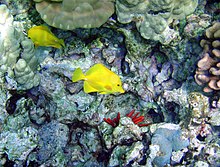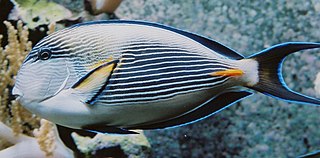
Acanthuridae are the family of surgeonfishes, tangs, and unicornfishes. The family includes about 86 extant species of marine fish living in tropical seas, usually around coral reefs. Many of the species are brightly colored and popular in aquaria.

The Moorish idol is a species of marine ray-finned fish belonging to the family Zanclidae. It is the only member of the monospecific genus Zanclus and the only extant species within the Zanclidae. This species is found on reefs in the Indo-Pacific region.

Zebrasoma is a genus of marine ray-finned fishes belonging to the family Acanthuridae which includes the surgeonfishes, unicornfishes and tangs. These fishes are found in the Indo-Pacific region.
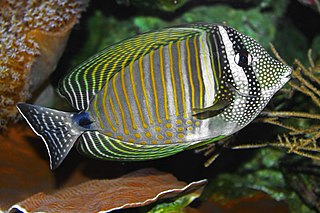
Zebrasoma desjardinii, the Red Sea sailfin tang, Desjardin's sailfin tang, Indian sailfin tang or Indian sailfin surgeonfish, is a species of marine ray-finned fish belonging to the family Acanthuridae, the surgeonfishes, unicornfishes and tangs. This fish is found in the Indian Ocean.

Acanthurus triostegus, the convict surgeonfish, convict surgeon, convict tang or fiveband surgeonfish, is a species of marine ray-finned fish belonging to the family Acanthuridae which includes the surgeonfishes, unicornfishes and tangs. This species has a wide Indo-Pacific distribution.
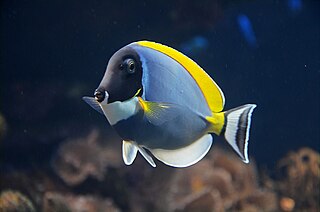
Acanthurus leucosternon, commonly known as the blue surgeonfish, powder blue tang or powder-blue surgeonfish, is a species of marine ray-finned fish belonging to the family Acanthuridae, the surgeonfishes, unicornfishes and tangs. This species is found in the Indian Ocean.

Acanthurus bahianus, the ocean surgeon or ocean surgeonfish, is a species of marine ray-finned fish belonging to the family Acanthuridae, the surgeonfishes, unicornfishes and tangs. This species is found on reefs in the Atlantic Ocean off the coast of Brazil. It is sometimes marketed as a food item, but it is more often used as bait, or in tropical saltwater aquaria.
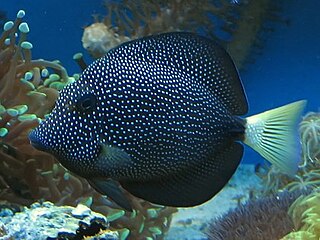
Zebrasoma gemmatum, the gem tang, jewelled tang, spotted tang or Mauritian tang, is a species of marine ray-finned fish belonging to the family Acanthuridae which includes the surgeonfishes, unicornfishes and tangs. This species is found in the Western Indian Ocean. The spotted tang is a highly prized specimen by marine aquarists and often commands high prices.
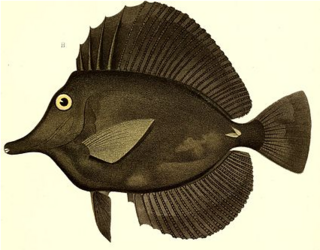
Zebrasoma rostratum, the longnose surgeonfish, longnose tang or black tang, is a species of marine ray-finned fish belonging to the family Acanthuridae, which includes the surgeonfishes, unicornfishes and tangs. This fish is found in the western central Pacific Ocean.

Zebrasoma scopas, the brown tang, twotone tang, scopas tang or brush-tail tang, is a species of marine ray-finned fish belonging to the family Acanthuridae which includes the surgeonfishes, unicornfishes and tangs. The brown tang is found throughout Oceania and is a herbivorous fish, feeding predominantly on filamentous algae. It is a highly popular fish in the aquarium trade.

The sailfin tang, the Pacific sailfin tang, purple sailfinned tang or sailfin surgeonfish, is a marine ray-finned fish belonging to the family Acanthuridae which includes the surgeonfishes, unicornfishes and tangs. This fish is found in the Pacific Ocean and is popular in the aquarium hobby.
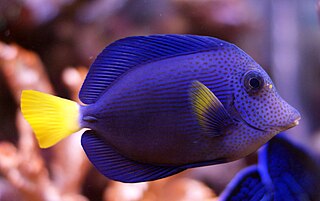
Zebrasoma xanthurum, the purple tang or yellowtail tang, is a species of marine ray-finned fish belonging to the family Acanthuridae which includes the surgeonfishes, unicornfishes and tangs. This species is endemic to the north western Indian Ocean.

Naso lituratus, the clown unicornfish, orangespined unicornfish, black-finned unicornfish, Pacific orangespined unicornfish, blackfinned unicornfish or stripefaced unicornfish, is a species of marine ray-finned fish belonging to the family Acanthuridae, the surgeonfishes, unicornfishes and tangs. This fish is found in the eastern Indian Ocean and western Pacific Ocean.
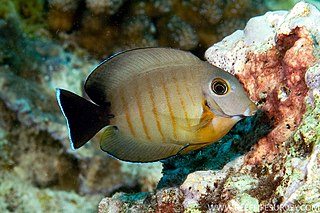
Acanthurus tristis, the Indian Ocean mimic surgeonfish, blackcheek surgeonfish or yellowspot surgeonfish, is a species of marine ray-finned fish belonging to the family Acanthuridae which includes the surgeonfishes, unicornfishes and tangs. This species is found in the eastern Indian Ocean.

Acanthurus nigricans, the goldrim surgeonfish, velvet surgeon, whitecheek surgeonfish, yellow-banded surgeonfish or yellowrimmed surgeonfish, is a species of marine ray-finned fish belonging to the family Acanthuridae, the surgeonfishes, unicornfishes and tangs. This species is found from the central Indo-Pacific area to the eastern Pacific coast, Hawaii included.

Ctenochaetus hawaiiensis thechevron tang, black surgeonfish, Hawaiian bristletooth, Hawaiian kole or Hawaiian surgeonfish is a species of marine ray-finned fish belonging to the family Acanthuridae which includes the surgeonfishes, unicornfishes and tangs. This fish is found in the tropical Pacific Ocean.

The slingjaw wrasse is a species of wrasse from the family Labridae which is native to the tropical waters of the Indo-Pacific where it occurs around coral reefs. This species is of minor importance to local commercial fisheries and can be found in the aquarium trade. Relatively mundane at first glance, this fish is notable for its highly protrusible jaws.

Acanthurus bariene, the bariene surgeonfish, black-spot surgeonfish, or eye-spot surgeonfish, is a species of marine ray-finned fish belonging to the family Acanthuridae, the surgeonfishes, unicornfishes and tangs. This species is found in the Indo-Pacific.

Ctenochaetus truncatus, the Indian gold-ring bristletooth, squaretail bristletooth, yelloweye bristletooth, truncate bristletooth or spotted yellow eye tang, is a species of marine ray-finned fish belonging to the family Acanthuridae which includes the surgeonfishes, unicornfishes and tangs. This fish is found in the Indian Ocean.

Naso caesius, the grey unicornfish or silverblotched unicornfish, is a species of marine ray-finned fish belonging to the family Acanthuridae, the surgeonfishes, unicornfishes and tangs. This species occurs in the Indo-Pacific region.

